
Antidesma is a genus of tropical plant in the family Phyllanthaceae formally described by Linnaeus in 1753. It is native to tropical Africa, S + E + SE Asia, Australia, and various oceanic islands. The greatest diversity occurs in Southeast Asia.

Mallotus is a genus of the spurge family Euphorbiaceae first described as a genus in 1790. Two species are found in tropical Africa and Madagascar. All the other species are found in East Asia, the Indian Subcontinent, Southeast Asia, eastern Australia, and certain islands of the western Pacific. The genus has about 150 species of dioecious trees or shrubs.
Trigonostemon is a plant genus of the family Euphorbiaceae and the sole member of its tribe (Trigonostemoneae). It was first described as a genus in 1826. It is native to Southeast Asia, southern China, the Indian Subcontinent, Queensland, and a few islands in the western Pacific.
Dicoelia is a plant genus of the family Phyllanthaceae. It was first described as a genus in 1879. It is native to Borneo and Sumatra.
- Dicoelia beccarianaBenth. - Borneo
- Dicoelia sumatranaWelzen - Sumatra
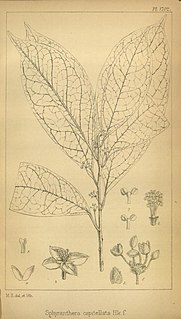
Sphyranthera is a plant genus of the family Euphorbiaceae and the only genus of its tribe (Sphyranthereae). It was first described in 1887. The entire genus is endemic to the Andaman & Nicobar Islands in the Bay of Bengal, politically part of India but geographically closer to Myanmar.
- Sphyranthera airyshawiiChakrab. & Vasudeva Rao - N Andaman Islands
- Sphyranthera lutescens(Kurz) Pax & K.Hoffm. - N Nicobar Islands + C Andaman Islands
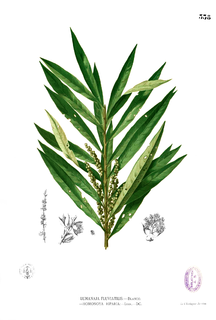
Homonoia is a plant genus of the family Euphorbiaceae first described in 1790. These are rheophytes and usually found in groups at riverbanks in India, southern China, Southeast Asia, and New Guinea.
- Homonoia intermediaHaines - India
- Homonoia retusa Müll.Arg. - India, Vietnam
- Homonoia riparia Lour. - Guangxi, Guizhou, Hainan, Sichuan, Taiwan, Yunnan, Cambodia, India, Assam, Bhutan, Sri Lanka, Borneo, Java, Lesser Sunda Islands, Sulawesi, Sumatra, Maluku, Laos, Malaysia, Myanmar, Philippines, Thailand, Vietnam, New Guinea, Andaman & Nicobar Islands
Lasiococca is a plant genus of the family Euphorbiaceae first described in 1887. These are small to relatively large trees found in scrubs or semi-evergreen forests. They grow in India, Indochina, Southeast Asia, and southern China.
- Lasiococca brevipes(Merr.) Welzen & S.E.C.Sierra - Peninsular Malaysia, Philippines, Lesser Sunda Islands, Sulawesi
- Lasiococca chaniiThin - Vietnam
- Lasiococca comberiHaines - Hainan, Yunnan, Vietnam, Thailand, E India
- Lasiococca lociiThin - Vietnam
- Lasiococca symphylliifolia(Kurz) Hook.f. - Sikkim
Trigonopleura is a plant genus of the family Peraceae, first described as a genus in 1887. It is native to Indonesia, Malaysia, and the Philippines.
- Trigonopleura dubia(Elmer) Merr. - Philippines
- Trigonopleura macrocarpaAiry Shaw - Sarawak
- Trigonopleura malayanaHook.f. - Peninsular Malaysia, Sumatra, Bangka, Borneo, Sulawesi
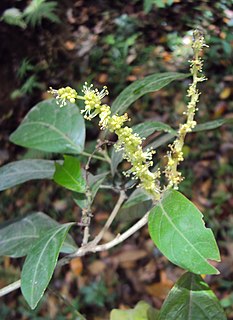
Epiprinus is a genus of plant of the family Euphorbiaceae first described as a genus in 1854. It is native to Indochina, Sumatra, southern China, and the Indian Subcontinent.
- Epiprinus balansae(Pax & K.Hoffm.) Gagnep. - Vietnam
- Epiprinus lanceifoliusCroizat - Vietnam
- Epiprinus malayanusGriff. - Myanmar, Thailand, Peninsular Malaysia, Sumatra
- Epiprinus mallotiformis(Müll.Arg.) Croizat - southern India
- Epiprinus poilaneiGagnep. - Vietnam
- Epiprinus siletianus(Baill.) Croizat - Hainan, Yunnan, Assam, Laos, Myanmar, Thailand, Vietnam
Cnesmone is a genus of plant of the family Euphorbiaceae first described as a genus in 1826. It is native to southern China and to much of Southeast Asia.

Endospermum is a genus of plants, under the family Euphorbiaceae and the monotypic subtribe Endosperminae first described as a genus in 1861 They are dioecious, rarely monoecious trees. It is native to E + S + SE Asia, Papuasia, Queensland, and certain islands of the W Pacific.
Ostodes is a genus of plants under the family Euphorbiaceae first described as a genus in 1826. It is native to southern China, the Himalayas, and parts of Southeast Asia.
- Ostodes kuangiiY.T.Chang - Yunnan
- Ostodes paniculataBlume - Hainan, Yunnan, Tibet, Nepal, Sikkim, Bhutan, N Bangladesh, Assam, Thailand, Myanmar, W Malaysia, Borneo, Java, Sumatra
Balakata is a genus of trees in the family Euphorbiaceae first described as a genus in 1999. It is native to Southeast Asia, southern China, the Himalayas, and New Guinea. The genus name was inspired by balákat-gúbat ("shoulder-tree"), the Philippine common name for B. luzonica.

Triadica is a plant genus of the family Euphorbiaceae first described as a genus in 1790. It is native to eastern southeastern, and southern Asia.

Aporosa is a genus of flowering plant belonging to the family Phyllanthaceae, first described as a genus in 1825. It is native to China, the Indian Subcontinent, Southeast Asia, Papuasia, and Queensland.

Cleistanthus is a plant genus of the family Phyllanthaceae, tribe Bridelieae, first described as a genus in 1848. It is widespread in much of the Old World Tropics in Asia, Africa, Australia, and various oceanic islands. Cleistanthus collinus is known for being toxic and may be the agent of homicides or suicides.

Pholidota, commonly known as rattlesnake orchids, is a genus of flowering plants from the orchid family, Orchidaceae. Plants in this genus are clump-forming epiphytes or lithophytes with pseudobulbs, each with a single large leaf and a large number of small, whitish flowers arranged in two ranks along a thin, wiry flowering stem that emerges from the top of the pseudobulb. There are about thirty five species native to areas from tropical and subtropical Asia to the southwestern Pacific.
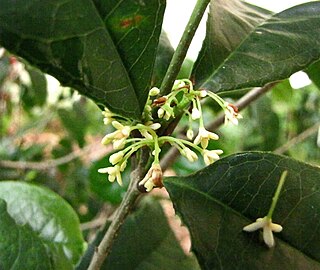
Sarcosperma is a genus of trees or shrubs in the family Sapotaceae. Their range is from India to southern China and Malesia.

Globba is a genus of plants in the ginger family. It contains about 100 species, native to China, the Indian Subcontinent, Southeast Asia, New Guinea, the Bismarck Archipelago and Queensland.
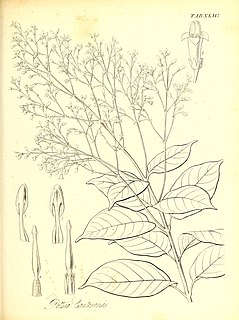
Pottsia is a genus of plants in the family Apocynaceae, first described as a genus in 1837. It is native to East and Southeast Asia.












